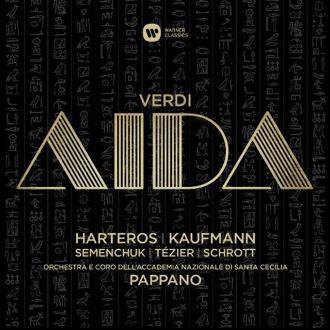|
|
|
|
|
|
|
|
|
Opera News, November 2015 |
| William R. Braun |
|
Critics Choice - Verdi: Aida
|
|
 OPERA
FANS of a certain age may now have a flashback. Here’s a recording of a
bread-and-butter opera, made in the studio, starring the leading couple
everybody wants to hear individually and in tandem. In the 1980s, it seemed
like these came out every week or so, and then it seemed like there hadn’t
been one since Nina Stemme and Plácido Domingo went into the studio ten
years ago for Tristan und Isolde. If neither of these perceptions is
strictly accurate, this new release lives up to expectations. Jonas
Kaufmann’s Radamès is sung with burnished tone not heard in the role since
the days of Bergonzi and Björling. His aria is long-breathed, his phrases
are elegantly tapered, and his tone is brighter and less baritonal than we
sometimes hear from him. If there’s still more room for artistry in the
expanse of thirty-two reiterated Bs in the tomb scene, the performance is
hardly lacking in any other regard. Anja Harteros, as Aida, is keenly
responsive to the music in the orchestra. She doesn’t shirk any of the
considerable demands of the role. The character is confident and determined
when she needs to be, even defiant at the start of the duet with Radamès in
Act III, making the end of the opera all the more poignant. The
unaccompanied line in the big “Ma tu, Re” ensemble is sung both as a musical
transition in the form of the number and as an emotional transition for
everyone onstage. OPERA
FANS of a certain age may now have a flashback. Here’s a recording of a
bread-and-butter opera, made in the studio, starring the leading couple
everybody wants to hear individually and in tandem. In the 1980s, it seemed
like these came out every week or so, and then it seemed like there hadn’t
been one since Nina Stemme and Plácido Domingo went into the studio ten
years ago for Tristan und Isolde. If neither of these perceptions is
strictly accurate, this new release lives up to expectations. Jonas
Kaufmann’s Radamès is sung with burnished tone not heard in the role since
the days of Bergonzi and Björling. His aria is long-breathed, his phrases
are elegantly tapered, and his tone is brighter and less baritonal than we
sometimes hear from him. If there’s still more room for artistry in the
expanse of thirty-two reiterated Bs in the tomb scene, the performance is
hardly lacking in any other regard. Anja Harteros, as Aida, is keenly
responsive to the music in the orchestra. She doesn’t shirk any of the
considerable demands of the role. The character is confident and determined
when she needs to be, even defiant at the start of the duet with Radamès in
Act III, making the end of the opera all the more poignant. The
unaccompanied line in the big “Ma tu, Re” ensemble is sung both as a musical
transition in the form of the number and as an emotional transition for
everyone onstage.
Conductor Antonio Pappano does some of his best
work in the duets, reminding us that Aida is most alive as a drama when
there are exactly two people onstage, and the trio in the first scene offers
momentum allied with tension. But “Su! del Nilo” is empty-headed. Perhaps
Pappano is making a statement about the futility of war. On the other hand,
Nikolaus Harnoncourt’s conducting of Aida may have been much-maligned, but
he showed that adherence to Verdi’s tempo relationships makes a stunning
moment of music drama when this ensemble, if done slowly rather than glibly,
slides into Aida’s panicked, private desperation in “Ritorna vincitor!”
Pappano’s performance generally makes for a red-sauce evening. But his
strikingly slow tempos at the start and end of Act III—the prelude losing
any sense of heat, night or languor, the opera stopping dead at “Io son
disonorato”—merely call attention to the conductor.
Ekaterina
Semenchuk is no steely Amazon as Amneris. There’s graceful, intimate singing
when required. The Met has engaged her for only a handful of Russian roles,
but on the basis of this recording she would do the house proud in wider
repertoire. Ludovic Tézier is a classy Amonasro, almost a romantic partner
for his Aida. (This makes sense in an opera in which everybody, even Radamès
at times, is working the angles.) Erwin Schrott is mostly unsteady as
Ramfis, a role that hardly requires anything but steadiness. For once the
bass trophy goes to the King, here the incisive Marco Spotti.
Even
those of us who mostly prefer live recordings have to admit that there’s a
lot to be said for Aida in the studio. The first scene can lead directly to
the temple scene without applause or scenery shifting. The coda to “O patria
mia,” with no pause for an ovation, can be interrupted midphrase by
Amonasro’s surprise appearance. Verdi, a supreme dramatist, counted on these
and other effects that we never experience in the theater. Add to this
singers who understand that Verdi may write espressivo on occasion but all
singing is meant to be espressivo, and you have quite a treat.
|
|
|
|
|
|
|
|
|
|
|
|
|